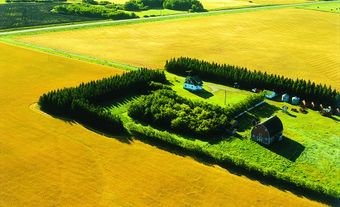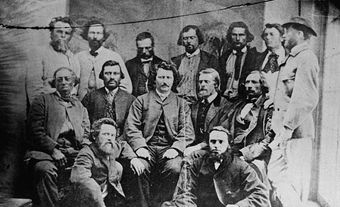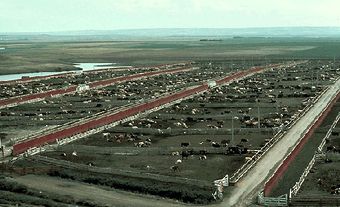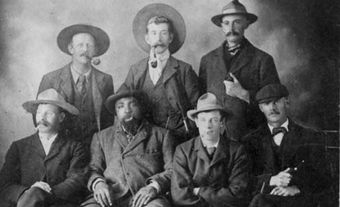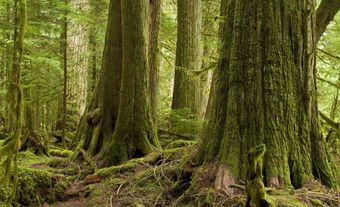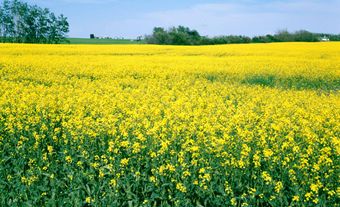Cowboys and cowgirls are people employed to tend cattle or horses. The first cowboys to work on the Canadian prairies arrived in the 1870s. The traditional cowboy lifestyle has since given way to a more contained, corporate model of ranching. But the romanticized image of the cowboy on the “open range” lives on as a symbol of the prairies. Today, the terms cowboy and cowgirl can refer to ranch workers or rodeo competitors.
Click here for definitions of key terms used in this article.

What Is a Cowboy or Cowgirl?
A cowboy or cowgirl is an animal herder primarily concerned with raising cattle or horses on ranches in North America. The origin of the word cowboy has racist roots. Before the American Civil War, enslaved Black men and women worked alongside white ranchers. White ranchers were called cow-hands, but enslaved Black workers were referred to as cow-boys. The word boy was used to infantilize and disrespect a Black rancher. The meaning of the word cowboy has changed over time. It is now used to refer to a person who herds and tends cattle and horses
Did you know?
Other names for the job are cowhand, cowpoke and cowpuncher.
Traditionally, cowboys or cowhands would watch over animals on open fields (“the open range”) and drive them to pasture or market as needed. These cowboys were almost all men. Occasionally, the wives or daughters of prominent ranchers also did this work. Since the closing of the prairie in the early 1900s, the term has come to refer to anyone who works on a ranch or takes part in traditional demonstrations of cowboy skills, known as rodeos. For this reason, the ranching and rodeo communities often distinguish “working cowboys/cowgirls” from “rodeo cowboys/cowgirls.”
Cowboys and cowgirls are known for their distinctive dress, part of a lifestyle descended from the Spanish vaquero tradition. Their look includes large, wide-brimmed hats, chaps and tall boots. They are also known for their skills, notably taming stubborn animals and specialized use of rope, including lassoing and tying up animals.
History of Cowboys in Canada
Early European settlers, including Hudson’s Bay Company traders, brought small herds of dairy cattle to the West as early as 1811. “Buckaroos” from the US territories of Oregon and Washington began driving beef cattle into British Columbia to sell to prospectors during the Fraser River Gold Rush in 1858. Some of these men stayed and established ranches. John Park, who ran the first large ranch in British Columbia, settled near Cache Creek in 1860 or soon thereafter.

The first herders calling themselves “cowboys” came to the Canadian prairies in the 1870s, driving cattle up from the US territories of Idaho and Montana. The romantic image of the cowboy emerged around this American culture east Rocky Mountains. British Columbia buckaroos eventually adopted the cowboy name and look.
Cowboys remained rare in Canada until the late 1870s. At that time on the prairies, hunters were killing bison to near extinction. Bison had been a main food source for Plains Indigenous peoples. Driven in part by a need for new food sources, First Nations began to sign land treaties with the Crown. The treaties moved these nations onto reserves. Through this process, the federal government opened up grassland to White settlement and agriculture. These changes, along with the creation of the North-West Mounted Police, drew more ranchers to the Canadian prairies. (See also History of Settlement in the Canadian Prairies.)
By 1886, there were 100,000 cattle east of the Rocky Mountains. They grazed on open pasture leased from the Canadian government. Leaseholders hired cowboys to mind the herds during winter and summer. Twice a year, they came together to “round up” the loose animals. There was a spring roundup for branding and a fall roundup to count the cows and take mature ones to market. This typically involved driving cattle across open plains from horseback. The destination was either local stockyards or train yards for shipping across the country or overseas. (See also Meat-Processing Industry.)

Most cowboys of this time were Americans who chose to stay after driving herds north from Idaho and Montana. Many saw the Canadian prairie as safer and more orderly than the American West. However, the enforced Prohibition against alcohol discouraged many cowboys from staying for long. Those that did became some of Canada’s most famous cowboys. They include Everett C. Johnson, who partially inspired the novel, film and television series The Virginian, and John Ware, a skilled cowboy and rancher who established his own ranch in Alberta.
Did you know?
Sources indicate that John Ware was born enslaved in the United States (see also Black Enslavement in Canada). His skills as a rancher suggest that he worked with horses while enslaved. It is likely that Ware gained his freedom at the close of the American Civil War (1865).
In 1882, he was hired to help bring 3,000 head of cattle from the United States to Sir Hugh Allan’s North-West Cattle Co. After the cattle run, he remained in the foothills area of what is now southern Alberta. He worked for several large cattle companies, including Bar U Ranch until 1884.
Ware established his own ranch in Alberta and was widely recognized for his strength, skilled farming techniques and skilled horsemanship.
The perceived romance of cowboy life — the promise of freedom in a rugged and beautiful landscape — drew many immigrants from overseas, primarily Great Britain. It also drew former North-West Mounted Police officers and Eastern Canadians. Westerners often viewed newcomers as “dudes” or “T. Eaton cowboys.” These scornful terms referred to lazy or unskilled people who only dressed like cowboys for social prestige or for pictures to send to family back home. But many immigrants proved capable enough to graduate from cowboys to ranchers.
First Nations and Métis peoples adopted some cowboy traditions and ran several successful ranches. Settlers rarely treated them as equals, despite stereotypes that suggested they were particularly gifted with horses. Many Chinese immigrants worked in ranching, but cooking was usually the only job open to them.
Cowboys and Cowgirls in Canada Today
Traditional cowboy culture began to die out in the early 20th century. An increase in settlement and the Canadian government’s desire to expand farmland led to the closing of the open prairie. Government officials surveyed and sold land to farmers and companies, who increasingly refused to let cattle range across their property. Ranchers continued to put animals out to pasture and bring them to market. But large seasonal roundups died out as ranches became clearly marked and contained. Since then, the typical ranch owner has been a family or corporation with ties to the meat-packing industry. The 2016 Canadian Agricultural Census identified 84,740 people who worked on farms or ranches that primarily made money from beef production. (See also Ranching History.)
Cowboy Culture in Canada

Cowboy and cowgirl culture overlaps little with the actual work of raising animals. Rodeos began as a way for cowboys to amuse each other and practise necessary skills. But they gradually grew into popular spectator events. The first organized rodeo in Canada took place at Fort Macleod, Alberta, in 1891. It featured steer roping and bronc riding. Horse racing became an event several years later, with Indigenous and “cowboy” riders competing in separate races.
In 1912, Calgary held its first Stampede. The organizer was Guy Weadick, a veteran of travelling American Wild West shows. Weadick promoted the Stampede specifically as a tribute to the memory of the region’s cowboys. The program featured competitors from across North America, including women in several events. It also introduced competitions such as “fancy roping” and “fancy riding.” The Calgary Stampede became an annual event in 1923. Today, it is the richest rodeo event in the world (in terms of total prize money awarded) and a symbol of the city. More than a million visitors come to the Stampede each year. Meanwhile, visitors to Alberta can experience a traditional cowboy lifestyle at certain sites. One example is the Bar U Ranch National Historic Site. Alberta also has working guest ranches that offer accommodation, tours and sometimes opportunities to help.
The figure of the cowboy has made a strong mark in popular culture. This owes mainly to Western-genre books and films, and to country music. Depictions of cowboys and cowgirls tend to draw on the American West. However, Canada has produced several well-known pop cultural figures who contributed to the cowboy mythos. The most notable of these are musicians Wilf Carter — also known as Montana Slim and The Yodelling Cowboy — and Ian Tyson.
Key Terms
Brand — A mark burned on the hide of livestock with hot iron that identifies its owner.
Cattle — Large ruminant animals with divided hoofs. Ruminant means they chew the half-digested food returned to their mouths from the first chamber of the stomach. Cattle include cows, oxen, bison and buffalo.
Cowboy (or cowhand) — A person, usually mounted on a horse, who herds and tends cattle or horses.
Ranch — A farm where cattle or horses are raised.

 Share on Facebook
Share on Facebook Share on X
Share on X Share by Email
Share by Email Share on Google Classroom
Share on Google Classroom
